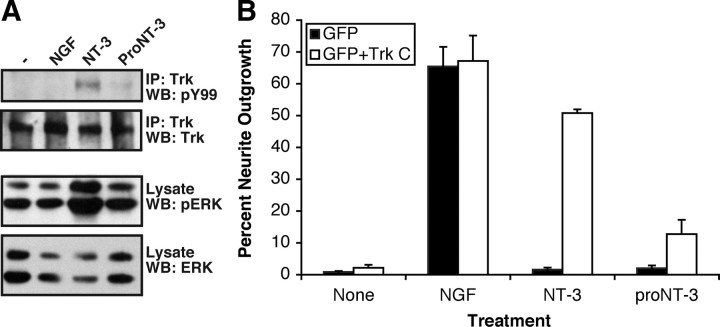Figure 4.
ProNT-3 does not activate TrkC. A, TrkA-deficient PC12nnr5 cells were transfected with a mammalian TrkC expression plasmid (Klein et al., 2005) followed by 500 μg/ml G418 selection to obtain TrkC-PC12nnr5 cell clones. Serum-starved TrkC-PC12nnr5 cells were treated, or not, with 100 ng/ml NGF, 25 ng/ml mature NT-3, or 25 ng/ml proNT-3 for 10 min as indicated. Detergent-extracted cellular lysates were immunoprecipitated with an anti-Trk antiserum followed by anti-phosphotyrosine Western blotting to assess TrkC activation. The blot was then reprobed with an anti-Trk antiserum to verify the presence of Trk in all the samples. In addition, whole-cell lysates were Western blotted with pERK or total ERK antibody to demonstrate ERK activation by NT-3, but not proNT-3, in TrkC-PC12nnr5 cells. B, Wild-type PC12 cells were transiently transfected with expression plasmids encoding GFP (to mark transfected cells) with or without TrkC. Forty-eight hours later, replica cultures were treated or not with 20 ng/ml NGF, and equal molar of NT-3 or proNT-3 (i.e., 20 ng/ml NT-3 or 40 ng/ml proNT-3) as indicated. The percentage of neurite-bearing populations were assessed 48 h later as described (see Materials and Methods). Data represent the results obtained from two independently conducted experiments. Error bars indicate ranges of values from two independent experiments.

